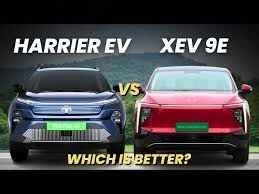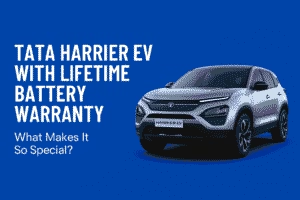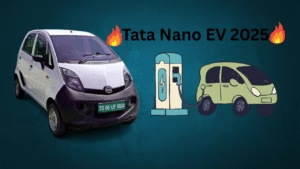The electric SUV market in India is heating up, with two homegrown giants, Tata Motors and Mahindra, vying for dominance. The Tata Harrier EV and Mahindra XEV 9e are flagship electric SUVs that promise cutting-edge technology, impressive performance, and eco-friendly driving. If you’re torn between these two, this detailed comparison will help you decide which one suits your needs. We’ll explore their design, performance, features, safety, and value for money in a human-friendly way, ensuring you get all the insights to make an informed choice.
Design and Style: Traditional vs Futuristic
The Tata Harrier EV carries a rugged, muscular look that closely resembles its ICE (Internal Combustion Engine) counterpart. Its bold stance, blanked-out grille, sleek LED DRLs, and connected tail lamps give it a commanding road presence. The Harrier EV features traditional door handles, a silver skid plate, and redesigned alloy wheels with aero covers, making it ideal for those who prefer a classic SUV silhouette with modern EV touches. Its dimensions are around 4.6 meters in length, offering a balanced profile for city and highway driving.
In contrast, the Mahindra XEV 9e embraces a futuristic, coupe-style design built on Mahindra’s born-electric INGLO platform. With a sleek, sloping roofline, flush door handles, and a full-width LED DRL strip, it exudes sci-fi sophistication. At 4.789 meters, it’s longer than the Harrier EV, giving it a more imposing stance. The XEV 9e’s 19-inch dual-tone alloy wheels and inverted L-shaped connected LED tail lamps add a premium flair, appealing to buyers who want a standout, modern aesthetic.
Verdict: The Harrier EV is for those who love a rugged, traditional SUV look, while the XEV 9e caters to buyers seeking a bold, futuristic vibe.
Performance and Range: Power Meets Efficiency
The Tata Harrier EV is a performance beast, boasting a dual-motor all-wheel-drive (AWD) setup that delivers a combined 396 PS (158 PS front + 238 PS rear) and 504 Nm of torque. It sprints from 0-100 km/h in just 6.3 seconds, making it one of the quickest electric SUVs in India. Available with 65 kWh and 75 kWh battery packs, it offers a claimed range of up to 622 km (MIDC). The Harrier EV supports 120 kW fast charging and features Vehicle-to-Load (V2L) and Vehicle-to-Vehicle (V2V) charging, enhancing its versatility.
The Mahindra XEV 9e comes with two battery options: 59 kWh (228 PS, 380 Nm) and 79 kWh (286 PS, 380 Nm), both rear-wheel-drive (RWD). It accelerates from 0-100 km/h in 6.8 seconds and offers an impressive range of 542 km (59 kWh) and 656 km (79 kWh, MIDC). The XEV 9e charges faster than the Harrier EV, giving it an edge for quick top-ups. However, it lacks AWD, which may limit its off-road prowess.
Verdict: The Harrier EV wins for raw power, AWD capability, and off-road features, while the XEV 9e excels in range and charging speed.
Features and Technology: Comfort and Convenience
Inside, the Tata Harrier EV feels premium with a 14.53-inch Samsung Neo QLED touchscreen, a 10.25-inch digital instrument cluster, and a digital inside rearview mirror (IRVM) with dashcam recording. It offers six terrain modes (Normal, Rock Crawl, Mud Ruts, Snow/Grass, Sand, Custom), a 540-degree surround camera with Transparent Mode, and advanced e-Valet features like Summon Mode and Anywhere Parking. Other highlights include dual-zone climate control, wireless charging, a panoramic sunroof, and Level 2 ADAS.
The Mahindra XEV 9e takes tech to another level with its 43-inch coast-to-coast triple-screen setup (three 12.3-inch displays), including a dedicated passenger screen. It features a 16-speaker Harman Kardon audio system with Dolby Atmos, a Qualcomm Snapdragon 8295 chipset, 24GB RAM, and 128GB storage, supporting over 60 apps. Additional perks include a panoramic sunroof with ambient lighting, ventilated front seats, wireless Apple CarPlay/Android Auto, and a powered boss mode for rear-seat comfort. However, it misses out on terrain modes and V2L/V2V capabilities.
The XEV 9e offers a tech-heavy, luxurious cabin, while the Harrier EV focuses on practical, adventure-ready features.
Safety: Protection on All Fronts
Both SUVs prioritize safety. The Tata Harrier EV comes with seven airbags, a 540-degree camera, Level 2 ADAS, hill hold/descent control, traction control, and ESP. Tata’s strong safety record, with multiple 5-star Bharat NCAP-rated models, adds confidence. The Mahindra XEV 9e matches up with six airbags, a 5-star Bharat NCAP rating, ESC, TPMS, a rear camera with sensors, and advanced driver assistance features.
Both are neck-and-neck in safety, offering robust protection for occupants.

Price and Value: Bang for Your Buck
The Tata Harrier EV starts at ₹21.49 lakh (ex-showroom), undercutting the Mahindra XEV 9e, which ranges from ₹22.65 lakh to ₹31.25 lakh. The Harrier EV’s AWD option, lower starting price, and off-road features make it a compelling value proposition for adventure enthusiasts. The XEV 9e, with its longer range, faster charging, and tech-laden cabin, justifies its premium for urban buyers prioritizing luxury and connectivity.
The Harrier EV is the better value for performance and versatility, while the XEV 9e appeals to tech-savvy buyers.
Which One Should You Buy?
Choosing between the Tata Harrier EV and Mahindra XEV 9e depends on your priorities. If you crave raw power, AWD capability, and off-road adventures, the Harrier EV is your pick. Its rugged design, segment-first features like Transparent Mode, and competitive pricing make it a versatile all-rounder. On the other hand, the XEV 9e is perfect for urban dwellers who value a futuristic design, superior range, and a tech-packed cabin with unmatched infotainment.
Both SUVs showcase India’s prowess in the EV space, offering strong alternatives to global brands. Test-drive them to see which one aligns with your lifestyle!





